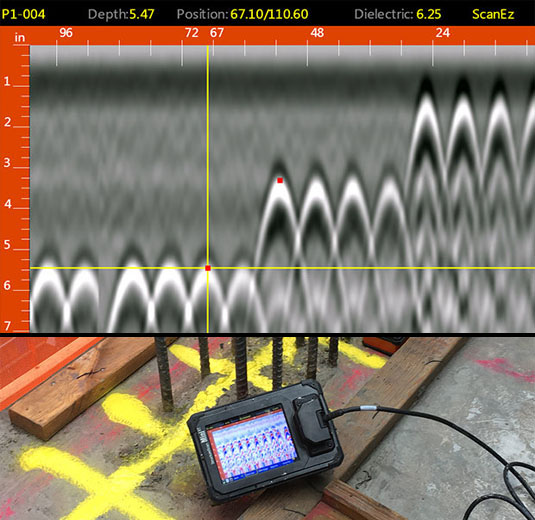Unveil the Transformative Power of Concrete Scanning in Making Best Use Of Effectiveness and Safety
Concrete scanning has emerged as an essential tool in the building and construction industry, supplying unmatched benefits in improving task effectiveness and guaranteeing safety and security requirements. The transformative power of concrete scanning exists in its capacity to supply real-time information and thorough understandings, reinventing exactly how jobs are prepared and performed.
Value of Concrete Scanning
Making certain the architectural stability and safety of building projects starts with the vital step of performing thorough concrete scanning. Concrete scanning is a non-destructive approach utilized to discover and map subsurface elements within concrete structures. This process is vital in identifying potential hazards, such as rebar, post-tension cables, and conduits, that might be hidden within the concrete. By making use of sophisticated innovations like ground-penetrating radar (GPR) and electro-magnetic induction, building and construction teams can properly find these aspects without triggering any damages to the structure.
Furthermore, concrete scanning assists in enhancing job timelines and spending plan by staying clear of unanticipated prices and hold-ups that might develop due to unpredicted blockages within the concrete. Eventually, investing in extensive concrete scanning is a positive technique that improves both efficiency and safety in construction tasks.
How Concrete Scanning Functions
Concrete scanning runs as an essential device in building and construction tasks by using sophisticated innovations to detect and map subsurface components without creating architectural damage. Ground Penetrating Radar (GPR) and Electromagnetic Induction (EMI) are 2 main approaches made use of in concrete scanning. GPR works by sending out high-frequency radar pulses right into the surface, which get better when they come across subsurface objects or gaps. The moment taken for the signal to return shows the depth and area of the items. EMI, on the other hand, makes use of electro-magnetic areas to identify variances in material compositions, such as determining rebar or channels within concrete structures.
Throughout the scanning process, the information accumulated is examined in real-time, permitting immediate identification of possible threats or barriers underneath the surface area. By employing these advanced innovations, concrete scanning dramatically lowers the threat of costly damages and injuries on building and construction websites.
Advantages of Concrete Scanning
One of the main benefits of concrete scanning is the ability to identify and find ingrained items such as rebar, post-tension cable televisions, and avenues properly. Concrete scanning aids in planning and creating a lot more efficiently, as it gives exact information regarding the place and depth of structural parts.

Study: Concrete Scanning Success

In one more instance, a construction business made use of 3D concrete scanning to analyze the condition old concrete structures in a historic structure. The detailed scans provided useful understandings into the degree of deterioration and assisted focus on upkeep efforts successfully. By proactively resolving areas of issue identified through scanning, the business had the ability to expand the life-span of the structure and guarantee owner safety.
These situation research studies emphasize the transformative power of concrete scanning in boosting performance, accuracy, and security in building jobs.
Applying Concrete Scanning in Projects
Applying innovative scanning modern technologies during construction projects my sources has actually come to be significantly crucial for enhancing precision and safety. By integrating concrete scanning right into task preparation and execution, construction teams can recognize prospective dangers, such as rebar or post-tension cords, hidden within concrete frameworks. This positive approach minimizes the risk of crashes, hold-ups, and pricey rework, inevitably bring about a lot more effective project timelines and budget plans.
To carry out concrete scanning efficiently, project supervisors must work together closely with skilled scanning professionals to determine one of the most appropriate scanning techniques for the specific project requirements. Involving scanning professionals from the beginning of a job enables the team to develop thorough scanning strategies that deal with essential areas of concern and guarantee complete data collection.
Furthermore, including concrete scanning into regular project workflows can improve decision-making processes, as real-time check data supplies immediate understandings into the condition of concrete structures - Concrete Scanning. This data-driven approach assists in informed analytical and enables teams learn this here now to make changes quickly, cultivating a culture of effectiveness and safety throughout the project lifecycle

Final Thought
To conclude, concrete scanning plays a vital duty in boosting effectiveness and security in building and construction projects. By using innovative modern technology to map and identify out underlying structures within concrete, this procedure assists to stop costly mistakes, guarantee structural stability, and decrease dangers on site. With the ability to discover hidden components and give exact data, concrete scanning confirms to be a beneficial device for maximizing project outcomes and optimizing overall success.
Concrete scanning is a non-destructive technique utilized to discover and map subsurface aspects within concrete frameworks. Furthermore, concrete scanning aids in maximizing task timelines and budget plan by preventing unforeseen expenses and hold-ups that might emerge due to unpredicted blockages within the concrete. One remarkable instance research study entails a large renovation project where concrete scanning played an important function in guaranteeing project success.In one more situation, a building company utilized 3D concrete scanning to assess the problem of aging concrete frameworks in a historical structure. By incorporating concrete scanning into project planning and implementation, construction teams can identify possible dangers, such as rebar or post-tension cable televisions, hidden within concrete frameworks.
Comments on “Improve Construction Security with Professional Concrete Scanning”